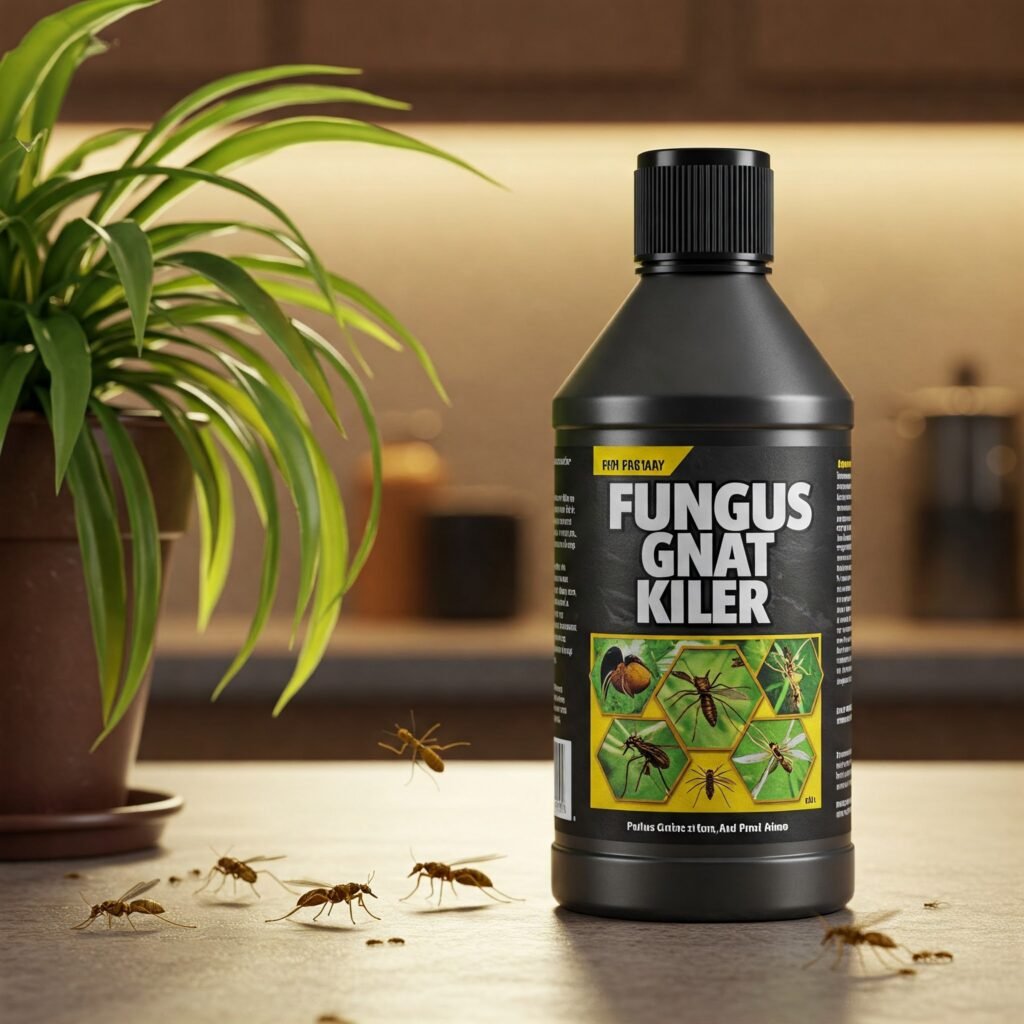Fungus gnats are tiny, annoying pests that can wreak havoc on your indoor plants. These small, flying insects thrive in moist environments and are often found buzzing around houseplants. If you’ve noticed these pests in your home, you’re likely searching for an effective fungus gnat killer to solve the problem.
In this blog post, we’ll explore 10 proven methods to eliminate fungus gnats and prevent them from returning. From natural remedies to commercial solutions, you’ll find everything you need to reclaim your home and protect your plants.
What Are Fungus Gnats?
Fungus gnats are small, dark-colored flies that belong to the Sciaridae family. They are often mistaken for fruit flies but are slightly larger and have longer legs. These pests are attracted to damp soil, which is why they’re commonly found around houseplants.
Adult fungus gnats are mostly harmless, but their larvae can cause significant damage to plants. The larvae feed on organic matter, fungi, and plant roots, which can stunt plant growth and even kill young seedlings.
Why You Need a Fungus Gnat Killer
A fungus gnat infestation can quickly get out of hand if not addressed. A single female gnat can lay up to 200 eggs, leading to a rapid increase in their population. Using a fungus gnat killer is essential to stop these pests from damaging your plants and taking over your home.
Not only do fungus gnats harm plants, but they can also be a nuisance as they fly around your living space. By addressing the problem early, you can save your plants and maintain a comfortable, pest-free environment.
1. Use Sticky Traps to Catch Adult Gnats
Sticky traps are a simple and effective way to control adult fungus gnats. These traps are coated with a sticky substance that attracts and captures flying insects.
To use sticky traps, place them near your plants or on the soil surface. The bright yellow color of the traps attracts the gnats, and once they land on the surface, they become stuck. This method is non-toxic and safe for use around pets and children.
Pro Tip: For larger infestations, use multiple traps and replace them regularly as they become covered with gnats.
2. Allow the Soil to Dry Out
Fungus gnats thrive in moist environments, so one of the easiest ways to combat them is by allowing the soil to dry out. Overwatering your plants creates the perfect breeding ground for these pests.
To use this method, reduce the frequency of watering and ensure that the top layer of soil dries completely between waterings. This will kill the larvae and prevent new eggs from hatching. For plants that require consistent moisture, consider using a well-draining soil mix to reduce excess water retention.
Pro Tip: Use a moisture meter to monitor soil moisture levels and avoid overwatering.
3. Apply Neem Oil to Kill Larvae
Neem oil is a natural and effective fungus gnat killer that works by disrupting the life cycle of the pests. It is derived from the seeds of the neem tree and is safe for use on most plants.
To use neem oil, mix it with water according to the instructions on the product label. Spray the solution on the soil surface and the leaves of your plants. The oil will kill the larvae and deter adult gnats from laying eggs. Repeat the application every few days until the infestation is under control.
Pro Tip: Apply neem oil in the evening to avoid harming beneficial insects like bees.
4. Introduce Beneficial Nematodes
Beneficial nematodes are microscopic worms that act as a natural fungus gnat killer. These nematodes prey on the larvae in the soil, effectively reducing the gnat population.
To use beneficial nematodes, mix them with water and apply the solution to the soil. The nematodes will seek out and destroy the larvae, preventing them from maturing into adult gnats. This method is organic and safe for use in homes with pets and children.
Pro Tip: Store nematodes in the refrigerator and use them immediately after mixing for the best results.

5. Use Hydrogen Peroxide to Kill Larvae
Hydrogen peroxide is a readily available household item that can double as a fungus gnat killer. When mixed with water, it releases oxygen and kills the larvae in the soil.
To create a hydrogen peroxide solution, mix one part 3% hydrogen peroxide with four parts water. Water your plants with this solution, ensuring that it reaches the root zone. The solution will kill the larvae without harming your plants. Repeat the process every few days until the gnats are gone.
Pro Tip: Avoid using hydrogen peroxide on delicate or sensitive plants, as it may cause damage.
6. Replace the Top Layer of Soil
If the infestation is severe, replacing the top layer of soil can help eliminate the larvae and eggs. Fungus gnats typically lay their eggs in the top inch of soil, so removing this layer can significantly reduce their population.
To do this, carefully scrape off the top layer of soil and replace it with fresh, sterile potting mix. Be sure to dispose of the infested soil away from your plants to prevent the gnats from returning.
Pro Tip: Sterilize the new soil by baking it in the oven at 180°F (82°C) for 30 minutes before use.
7. Use a Commercial Fungus Gnat Killer
For persistent infestations, a commercial fungus gnat killer may be necessary. These products are specifically designed to target fungus gnats and are available in various forms, including sprays, granules, and drenches.
When using a commercial product, always follow the instructions on the label to ensure safe and effective application. Some products may require multiple applications to completely eliminate the gnats.
Pro Tip: Look for products containing Bacillus thuringiensis (Bt), a natural bacteria that targets gnat larvae.
8. Improve Air Circulation Around Plants
Fungus gnats thrive in stagnant, humid environments. Improving air circulation around your plants can make the area less inviting for these pests.
To improve air circulation, use a fan to keep the air moving around your plants. You can also space out your plants to reduce humidity levels. This simple step can help prevent future infestations.
Pro Tip: Open windows or use a dehumidifier to reduce overall humidity in your home.
9. Use Sand or Gravel as a Top Dressing
Adding a layer of sand or gravel to the top of your soil can deter fungus gnats from laying eggs. The coarse texture makes it difficult for the gnats to access the soil, effectively reducing their population.
To use this method, spread a thin layer of sand or gravel over the soil surface. Be sure to cover the entire surface to create an effective barrier. This method is particularly useful for plants that require frequent watering.
Pro Tip: Use horticultural sand for best results, as it is sterile and free of pests.
10. Keep Your Home Clean and Free of Debris
Fungus gnats are attracted to organic debris, such as fallen leaves and dead plant material. Keeping your home clean and free of debris can help prevent these pests from taking up residence.
Regularly clean your plant pots, trays, and surrounding areas to remove any organic matter that may attract gnats. This simple step can go a long way in preventing future infestations.
Pro Tip: Use a small vacuum to remove gnats and debris from hard-to-reach areas.
Additional Tips for Fungus Gnat Prevention
Here are a few extra tips to help you keep fungus gnats at bay:
- Quarantine New Plants: Isolate new plants for a few weeks to ensure they are pest-free before introducing them to your home.
- Use Yellow Sticky Cards: Place yellow sticky cards near windows and doors to catch gnats before they enter your home.
- Avoid Over-Fertilizing: Excess fertilizer can create an ideal environment for fungus gnats. Use fertilizers sparingly and follow the recommended dosage.
Conclusion
Dealing with a fungus gnat infestation can be frustrating, but with the right strategies, you can eliminate these pests and protect your plants. Whether you opt for natural remedies like neem oil and beneficial nematodes or use a commercial fungus gnat killer, the key is to act quickly and consistently.
By following the tips outlined in this blog post, you can create a pest-free environment for your plants and enjoy a healthier, more vibrant indoor garden. Remember, prevention is just as important as treatment, so take steps to avoid future infestations and keep your home gnat-free.
